If you’d rather listen to Tim read 10 Simple Ways to Get Clients From Your Coaching Website in 2023 and also expand on it (euphemism for going wildly off-script), click below.
Most online coaches are struggling to attract clients willing to pay them what they are worth.
One of the reasons is that most coaching websites sit somewhere on s scale between inadequate and utterly tragic.
Some look good, some look bad and many are in between.
But almost none are set up to convert visitors into subscribers and/or clients.
Your coaching website is almost certainly your most important asset when it comes to your online marketing.
It’s effectively your shop window and will often be the first point of contact with potential clients.
So, it has to be right.
Here’s how you get it right and why the Fully Booked Coach is set up the way it is.
If you have any questions or comments, please leave a comment. And if you like the post, please rate it and even share!
1. Make sure your About page isn’t about you on your coaching website

I know this sounds counterintuitive, but the About page on your coaching website really isn’t about you.
Well okay, it kinda is, but it should mainly be about your ideal client.
For the most part, visitors to your coaching website don’t care about you.
They just care about what you can do for them.
They’re not interested in where you went for your last vacation, that you love knitting sweaters for homeless rabbits, or that you once saw the Virgin Mary in a bowl of soup.
Also, and rather remarkably, most of your visitors don’t care that much about your coaching qualifications either.
What your readers care about are the obstacles you’ve overcome, the adversity you’ve bounced back from, and the dragons you’ve slain that are relatable and meaningful to them.
As a coach, you will be able to relate to my story of struggling for 3 years to get clients and almost quitting on numerous occasions.
You know from the get-go that I understand what you’re going through because I went through it too and can almost certainly help you.
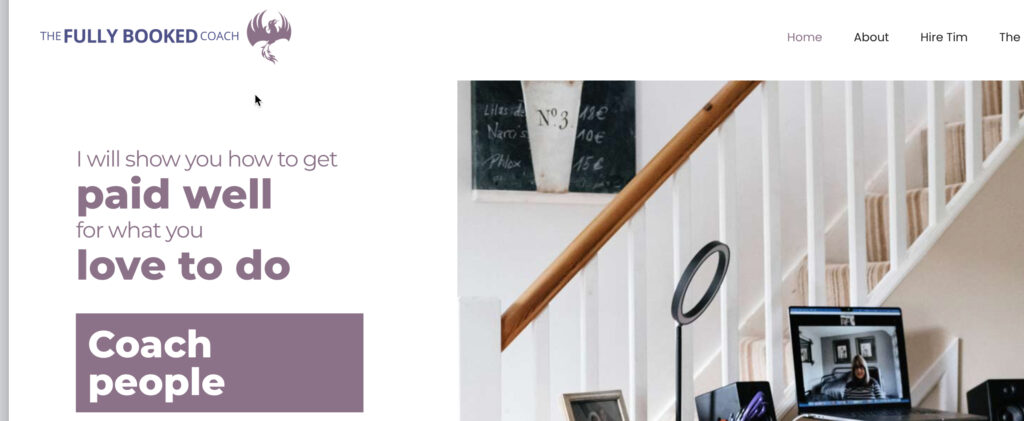
2. Make sure people immediately know what you can do for them
Does your coaching website immediately and clearly articulate the benefits of hiring you?
If you have any doubt whatsoever, get somebody who doesn’t know what you really do and ask them.
If they have any doubts, then it doesn’t.
You have a handful of seconds to deliver that message before the back button has been hit and your potential client has gone for good.
The screenshot above is taken from my home page, it makes it perfectly clear what I do and who I help.
I help coaches get paid for coaching.
If you’re a coach who wants to get paid for coaching then I will almost certainly have your attention.
And at that stage, that’s all I want.
3. Have CTA’s on EVERY page
A CTA is a call to action and you should have at least one on every page of your coaching website.
It’s best to have just one (two at the most) because if you have too many you risk confusing people into doing nothing.
On a longer page (especially a sales page) you should replicate the same CTA multiple times so people don’t have to scroll up or down to act. But keep the CTA consistent as much as possible.
When coaches land on the homepage of the Fully Booked Coach I want them to subscribe to my newsletter so I can start to offer value and build their trust.
As such, the CTA’s down the page reflect that desire by offering them my lead magnet (more in a moment) in return for subscribing.
If somebody is still reading by the time they get to the bottom of the page then there is the option (CTA) of booking a consult, but it’s not my main focus on that specific page.
Of course, if people navigate to the Hire Tim or Contact page then the CTAs change accordingly so they can book a Zoom consult, or email me.
By the way, if you click the button (or even here) you can get my book and I think you will like it.
4. Have a lead magnet/opt-in
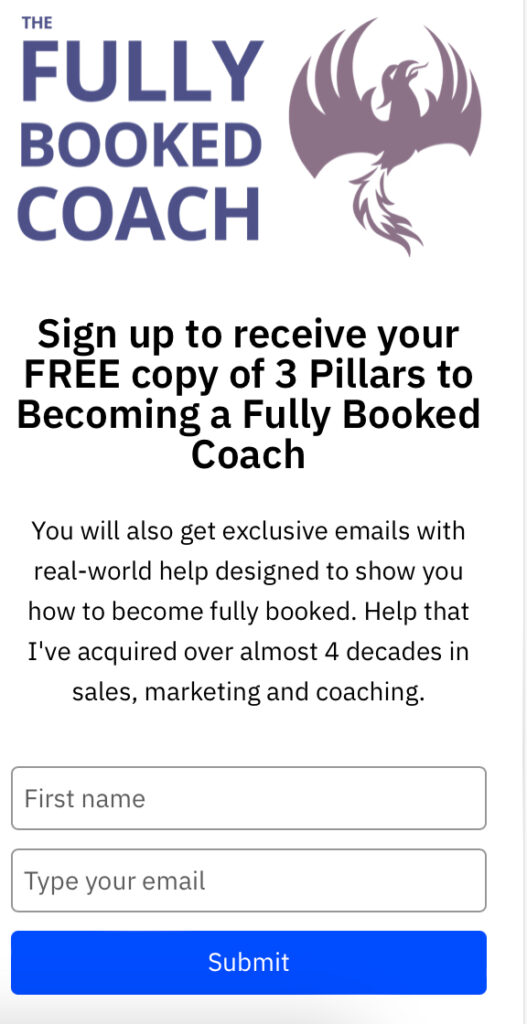
A lead magnet, otherwise known as a freebie, is the thing that you give people for subscribing to your newsletter.
You must have one and it must offer real value.
If you couldn’t charge £5 or $5 for your lead magnet, then it’s not good enough.
My book, 3 Pillars to Becoming a Fully Booked Coach took me a long time to write and edit.
I then spent several hundred pounds having it designed so it looks great.
All for something I then give away.
But for many people, that book is my first opportunity to show them I know my shit (and I do).
Few people will read every page on a website, but they will sit down and read a book.
Your lead magnet doesn’t have to be an ebook.
It could be a series of emails, an audio program, a white paper, a report, or a sequence of videos.
It really doesn’t matter what it is as long as it has standalone value for your ideal client and can be delivered digitally.
And it must be obvious and easy for people to sign upto get it.
Pop-ups are a pain in the ass, but they are a pain in the ass that will help you get prospective clients onto your newsletter list. So use one.
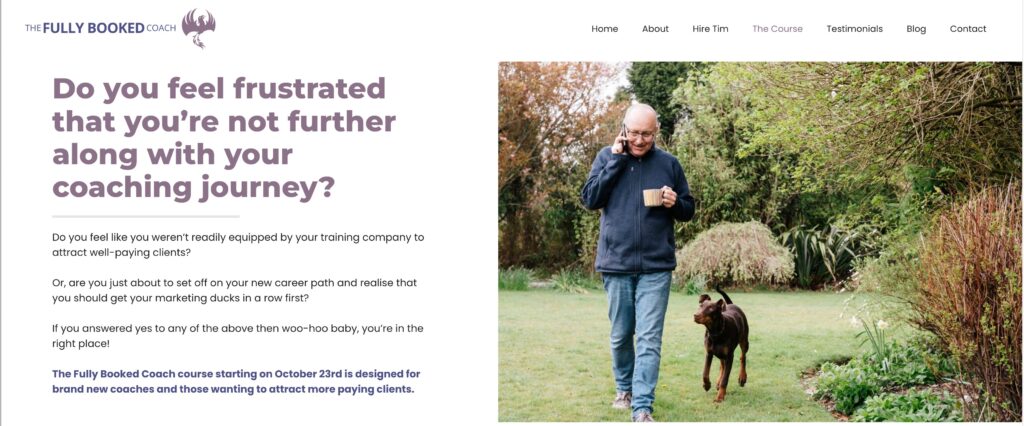
5. Use warm photos of YOU
We are in the business of connecting and building trust.
Nobody hires a coach who they don’t connect with and trust.
Warm welcoming images of you allow you to immediately connect with people.
Nobody connects with a picture of a flower, a beach, or even a fucking dolphin.
Well, ok, maybe some people connect with dolphins, but nobody hires one to coach them.
If you’re nervous about uploading your photo (and a decent one- no shit iPhone selfies please) because of what others may think, you’re probably in the wrong job.
It’s okay if you’re a tad overweight, have lost most of your hair, and aren’t aging especially gracefully.
Er, wait a minute, that’s me!
Shit!
Oh well, at least Millie looks young and sprightly.
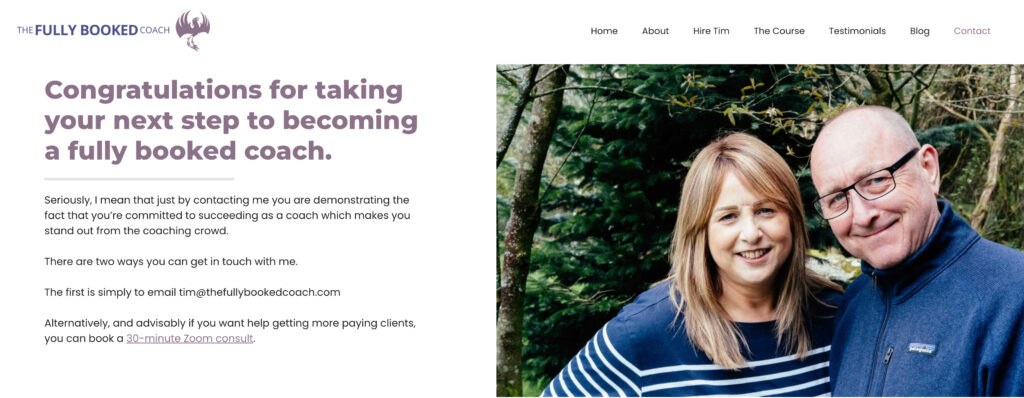
6. Get your contact page right
Shockingly, your contact page may be the most important on your site.
Yet, it’s often the most neglected by coaches on their website.
Most people who take the trouble to view it will be considering hiring you to be their coach.
Why else would they go to your contact page?
But, just because they’re considering it doesn’t mean they complete the next phase and actually do it.
As such, you should make the page welcoming, and reassuring.
And the process of contacting you should be as easy and straightforward as possible.
You should also then explain what they can expect next.
I have my email address and also two links to book a Zoom consult on my contact page.
In an ideal world, I’d like to have my phone number prominently displayed and clickable too.
Sadly, however, my cell service is so bad where I live that it could create more problems than it’s worth.
Note: Never have links to your Social Media accounts from your Contact Page. You have worked hard to get people there, don’t give them the opportunity to drift off again.
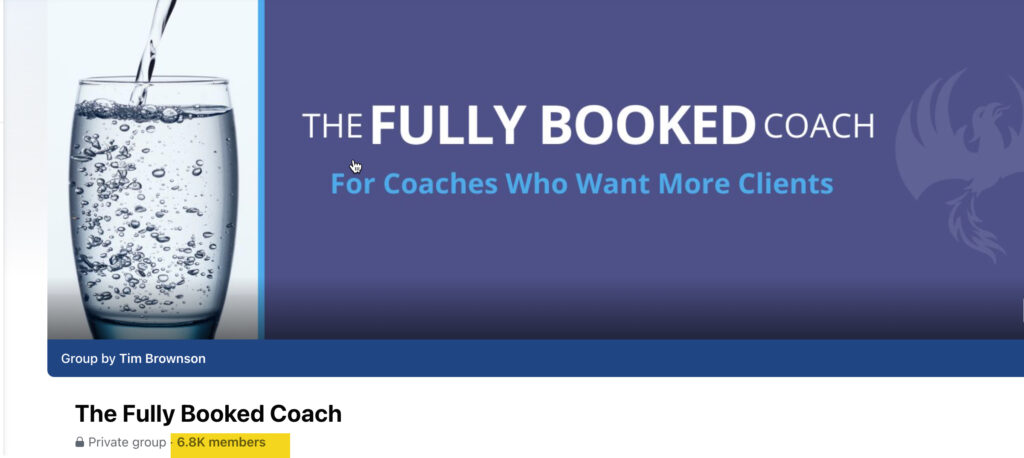
7. Use social proof
Nobody walks into an empty restaurant when the one next door is bustling and vibrant.
People rarely buy books that have zero reviews.
And few people want to see a movie that has zero buzz around it.
We all use social proof in this manner because it allows us to make rapid decisions that are more likely to be right.
Examples of social proof you can use as a coach to build credibility and trustworthiness quickly and effectively are:
- Testimonials
- Blog comments
- Books you have written (especially if you are published rather than self-published)
- Newsletter subscribers
- Social media followers
- Social media shares
- Online reviews about your coaching
- Being interviewed on Radio/TV/Podcast about your niche
It should go without saying that any social proof has to be relevant.
Having a clip of you being interviewed on TV because your cat got stuck up a tree and then a firefighter got stuck up there too trying to rescue it, and now there is a cat attacking a firefighter up a tree, is not social proof.
I backed off from using social proof for years because it felt like I was being arrogant.
It’s not being arrogant, it’s being smart and helping assuage any fears people may have about hiring you.

8. Set up your testimonial page properly
As mentioned, testimonials can help massively in building social proof.
However, it’s not just a question of slapping them up there and hoping for the best.
It’s easy to buy fake testimonials and people know that, so you need to do everything in your power to show they are legitimate.
You do that by using full names and if possible linking through to one of their social media profiles.
I tend to link to my client’s websites because that clearly shows they are real coaches and real people.
Videos work best with photos a close second, but you always need a full name.
Anonymous testimonials or ones that just use a first name are probably harmful.
Also, try and mix them up.
It’s fine to have an occasional longer testimonial if you also have some shorter ones that people can scan or watch quickly.
Note: A lack of testimonials (less than 4 or 5) can just trigger red flags that you’re either a brand new coach or not very good.
I’d hold back on a testimonial page until you have at least 6.
Alternatively, you could sprinkle them through the site so it’s not obvious how many there are.

9. Keep your site updated
If you have an events page make sure that it’s not months since you posted anything.
Or that you’re still advertising a course that took place in 2019.
Make sure the copyright information in your footer says the current year.
Don’t link to social media accounts that you haven’t posted to in months or even years.
And if you only blog occasionally, set it up so the date of publication isn’t publicly visible.
If your site looks out of date, you will be out of clients.
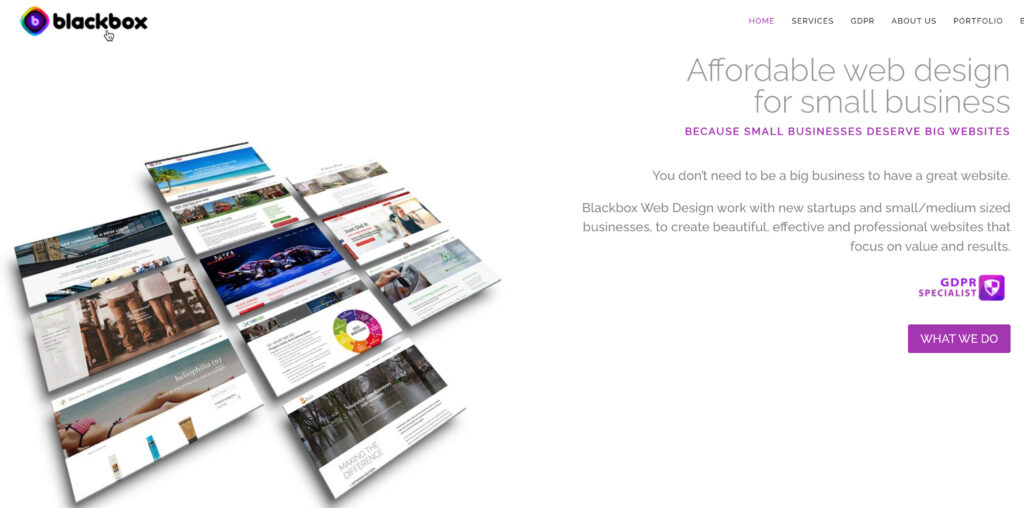
10. Hire a designer
Of course, you could just hire a great designer who knows most of this shit and hire me to help you liaise.
If you do want to go down that route, I can HIGHLY recommend my own designer, Paul from BlackBox
Conclusion
Most of the mistakes I see on coaching websites are relatively easy to correct.
None of the above requires you to have an intimate knowledge of HTML or CSS.
Most are just copy and image changes that can be done either free by yourself, or fairly cheaply and quickly by your designer.
Hopefully, this post has given you plenty to think about.
If you have any thoughts you’d like to share, I’d love to hear them in the comments below.
Similarly, any social media shares would be gratefully appreciated because it will give me social proof!

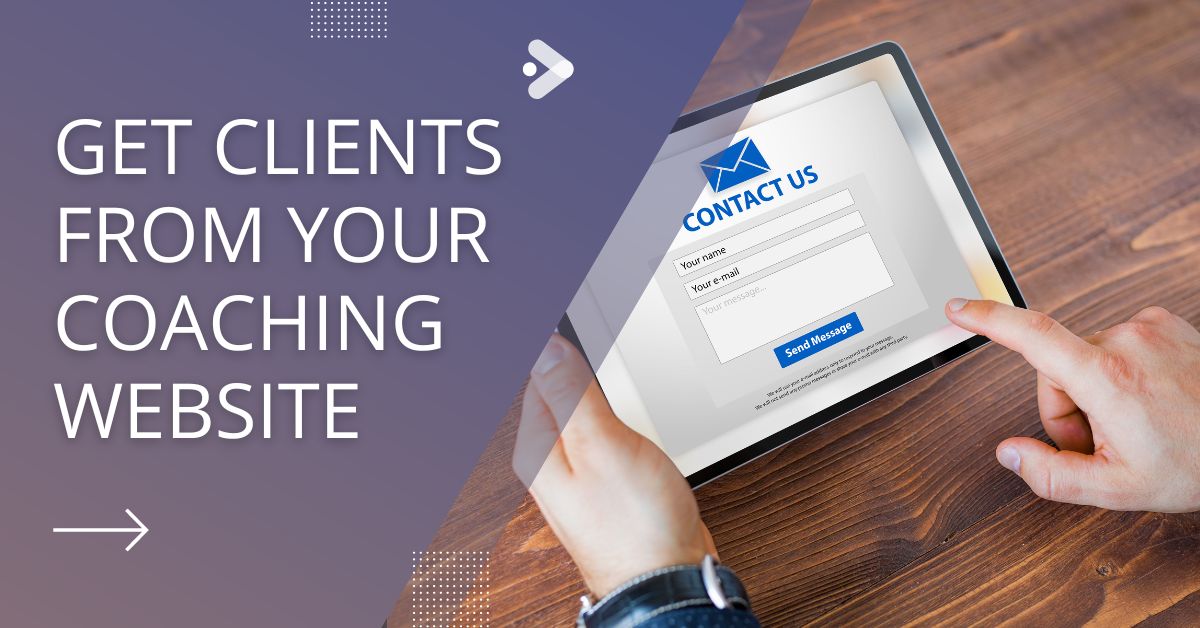

Tim, thank you for clarifying the importance of the items you listed in this post. I’m still working on getting updates done to mine.